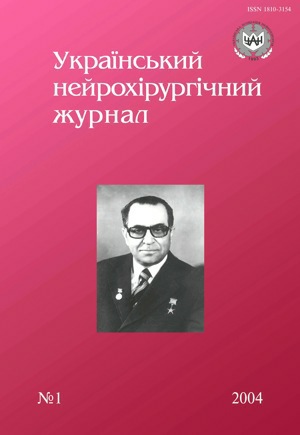Results of the treatment of median and ulnar nerves tunnel neuropathies
Keywords:
tunnel neuropathy, surgical treatmentAbstract
We analyzed 65 patients with tunnel neuropathies (TN) who were operated on in the department of rehabilitation nerosurgery from 1994 to 2003. Age of patients — from 13 to75 years old, males — 73%, females — 27%. Distribution of lesion location was following: cubital channel 46, carpal channel-11, in6 cases both levels were involved. Surgical interventions include neurolisis and decompression of nerve trunks and theirs branches with insertion of stimulating electrode if needed.
In the majority cases management of median nerve compression in carpal channel comprises in dissection of its anterior wall — carpal ligament. That resulting in enlargement of space in carpal channel ant to decrease on intrachannel pressure. Our results indicating necessity of early decompression and neurolisis for better nerve regeneration. The best timing for surgical intervention is the period from 1 to 6 months after onset of clinical symptoms.
References
Истратов С. Н. Особенности клиники, диагностики и лечение туннельных невропатий: Автореф. дис. ... канд. мед. наук . — Санкт-Петербург,1999.— С.4.
Карлов В.А. Неврология. Руководство для врачей. — М.: МИА, 1999.— С. 348–353.
Короткевич М.М. Хирургическое лечение туннельных невропатий области шеи и верхних конечностей: Автореф. дис. ... канд. мед. наук. — Санкт-Петербург, 1999.— С. 3.
Рахматулин Т.Р., Рахматулин Р.М. К вопросу хирургического лечения туннельной невропатии // Третий съезд нейрохирургов России.— Санкт-Петербург, 2002.— С.534.
Agee J.M., McCarrol H.R., North E.R. Endoscopic carpal tunnel release using the single proximal incision technique // Hand Clin.— 1994. —V.10. — Р. 647–659.
Asbury A.K., Guliatt R.W. Pheripheral Nerve Dizorders// М.: Медицина, 1987.—297—341.
Campbell W.W. Diagnosis and management of common compression and entrapment neuropathies // Neurol. Clin. — 1997. — V.15, №3. — P. 549–567.
Chow J.C.Y. The Chow technique of endoscopic release of the carpal ligament for carpal tunnel syndrome: foyr years of clinical results // Arthroscopy.— 1993.— №9.— Р.301–314.
Degeorges R., Masquelet A.C. The cubital tunnel: anatomical study of its distal part // Surg. Radiol. Anat. — 2002.— V.24, N3–4.—Р.169–76.
Kern R.Z. The electrodiagnosis of ulnar nerve entrapment at the elbow //Can J. Neurol. Sci.— 2003.— V.30, N4.—Р.314–319.
Markowicz A., Jablonska J., Nyka W., Rogoza P., Biernacka A. Results of surgical treatment for cubital tunnel syndrome (Article in Polish) // Chir. Narzadow. Ruchu. Ortop. Pol.— 2002.— V.67, N5.—Р.509–14.
Мatev B.Cubital tunnel syndrome // Hand Surg.— 2003.— V. 8(1).—Р.127–131.
Menon J. Endoscopic carpal tunnel release: preliminary report // Arthroscopy.—1994.—№10. — Р. 31–38.
Nakano K.K. Nerve entrapment syndromes // Curr. Opin. Rheumatol. — 1997. — V. 9, №2. — P. 165–173.
Nawrot P., Romanowski L., Nowakowski A. Cubital tunnel syndrome: evaluation of anterior subcutaneous transposition of the ulnar nerve [Article in Polish] // Chir. Narzadow. Ruchu. Ortop. Pol.— 2002. — V. 67, N3.—Р.291–294.
Pecina Marko M., Jelena Krmpotic-Nemanic, Andrew D. Markiewitz Third Edition. Tunnel Syndromes // СRC PRESS. — 2001.— Р.123–134.
Rich B.C., McKay M.P. The Cubital Tunnel syndrome: a case report and discussion // J. Emerg. Med.— 2002.— V. 23, N4.—Р.347–350.
Uchiyama S., Yasutomi T., Fukuzawa T., Nakagawa H., Kamimura M., Miyasaka T. Median nerve damage during two-portal endoscopic carpal tunnel release // Clin. Neurophysiol.— 2004.— V. 115, N1.—Р.59–63.
Downloads
How to Cite
Issue
Section
License
Copyright (c) 2004 V. I. Tsymbaliuk, I. B. Tretiak, J. V. Tsymbaliuk

This work is licensed under a Creative Commons Attribution 4.0 International License.
Ukrainian Neurosurgical Journal abides by the CREATIVE COMMONS copyright rights and permissions for open access journals.
Authors, who are published in this Journal, agree to the following conditions:
1. The authors reserve the right to authorship of the work and pass the first publication right of this work to the Journal under the terms of Creative Commons Attribution License, which allows others to freely distribute the published research with the obligatory reference to the authors of the original work and the first publication of the work in this Journal.
2. The authors have the right to conclude separate supplement agreements that relate to non-exclusive work distribution in the form of which it has been published by the Journal (for example, to upload the work to the online storage of the Journal or publish it as part of a monograph), provided that the reference to the first publication of the work in this Journal is included.









